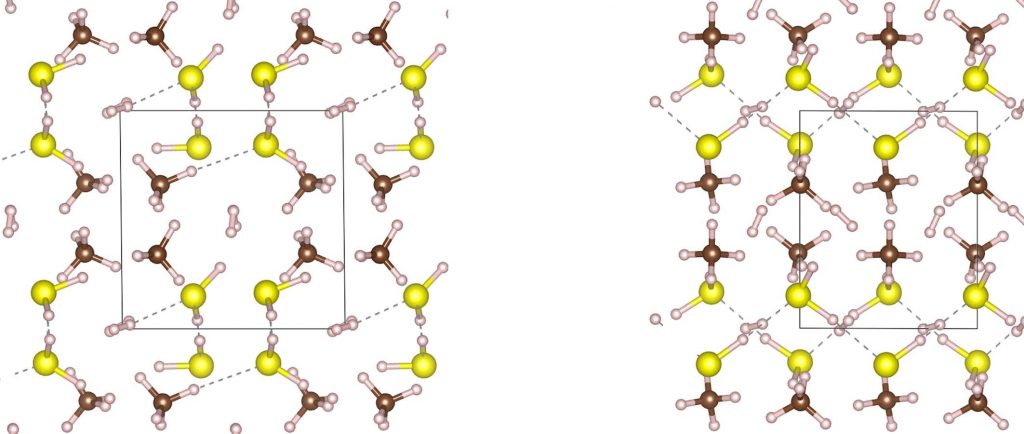The title of this post indicates the exciting prospect that a method of producing a room temperature superconductor has finally been achived[cite]10.1038/s41586-020-2801-z[/cite]. This is only possible at enormous pressures however; >267 gigaPascals (GPa) or 2,635,023 atmospheres.
The system is made by milling a mixture of elemental carbon and sulfur, followed by adding hydrogen gas, compression to 4 GPa and finally laser-induced photolysis at 532nm for several hours. The result of this is the production of three entirely unexotic molecules, H2S, CH4 and H2 in approximately stoichiometic quantities, which at this pressure form a complex bound by van der Waals attractions. Since in this blog, I am particularly interested in molecular structures, my eye was drawn to “Extended data Figure 6, A DFT-optimized structure for (H2S)(CH4)H2 (variant 2) at 4 GPa. This structure was produced by DFT optimisation modelled at 4 GPa using the PBE functional and importantly the now standard Grimme dispersion correction (often indicated as GD3+BJ, and used frequently on this blog). Since this complex is bound by dispersion attractions, it might be tempting to conclude that the intermolecular features of this structure originate in part from the Grimme dispersion model† as well as possible hydrogen bonding from quantum effects.
I would love to be able to play with this structure to e.g. measure properties such as hydrogen bonding lengths or perform e.g. a QTAIM analysis,♥ but have not yet acquired the “extended data” of figure 6 in the form of coordinates.‡ I have italicised the term extended data, being unsure what the journal means by this. If the figure relates to the three-dimensional extended structure of the crystal form of this complex, then one might imagine that any extended data associated with this figure would indeed be the numerical coordinates. Since the authors express the hope that “chemical tuning” of this system might enable complexes exhibiting superconductivity at lower pressures, I fancy that these coordinates might help provide insight into how to achieve such tuning. This closing paragraph of mine arose because I still frequently fail to see even prestiguous journals doing very much to encourage FAIR data associated with articles. In this instance, FAIR, at least to my mind is more than just a Figure (with or without extended data), but is genuinely inter-operable (I) or re-usable (R) data such as indeed are coordinates. To this end, I am unconvinced that this “extended data figure” is indeed properly FAIR.
‡I have requested these from the authors, and hope to make them available in the form of a 3D rotatable model here on the blog. †It would be interesting to know if this model has been tested at the enormous pressures in this experiment. Standard dispersion models pertain to normal pressures. ♥As was done here for Na2He.
